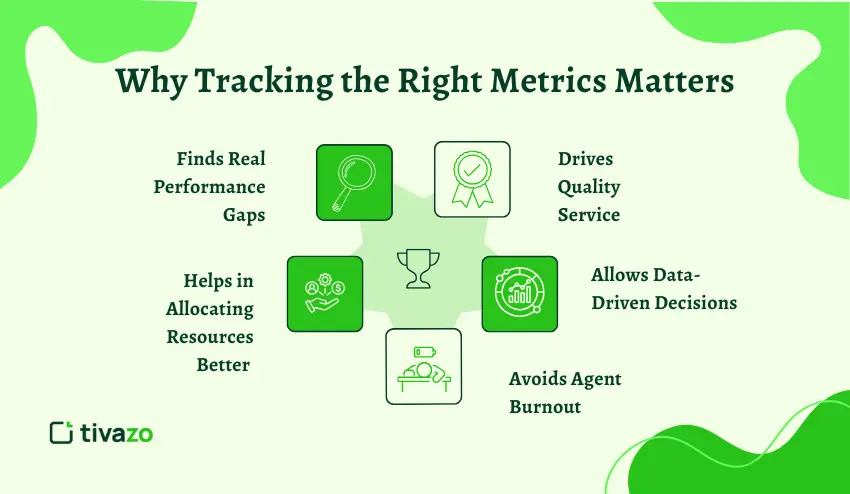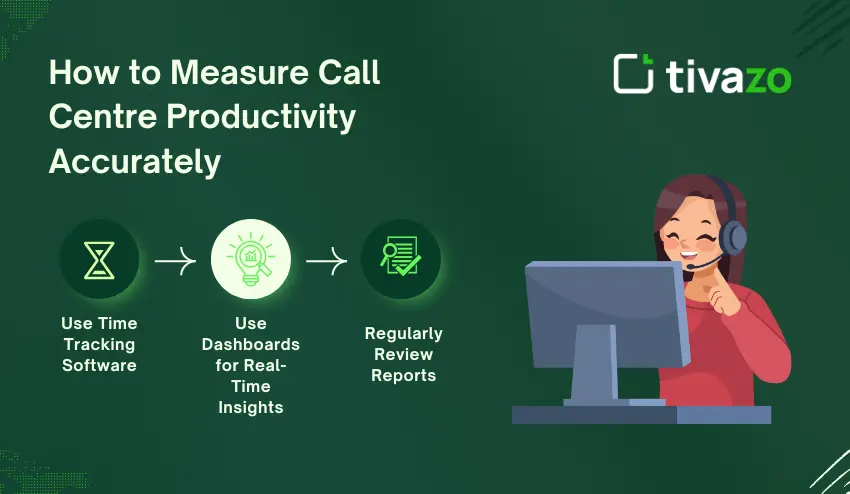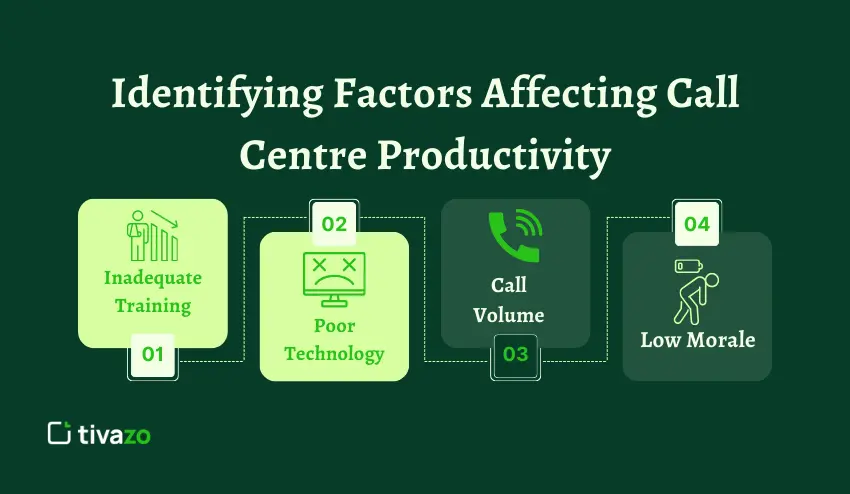Introduction
Each unanswered phone, a lengthy queue, or a delayed consumer-related problem can waste thousands of dollars of business. In the case of call centres, efficiency is not a metric; it is the spine of customer satisfaction and business.
Call centre productivity is used to measure how well your staff is processing the calls without compromising the quality of service. By paying attention to the correct metrics, managers create clearly identified loopholes, streamline work processes, and improve agent performance.
In this guide, we are going to cover the true productivity metrics that count, the usual factors that impact performance, and some actionable steps to improve efficiency. When you comprehend and optimise these measures, you can make a difference to the performance of your agents and the customer experience.
Key Highlights:
- What is Call Centre Productivity?
- Why Tracking the Right Metrics Matters
- Core Call Centre Productivity Metrics
- How to Measure Call Centre Productivity Accurately
- Supporting Metrics to Track
- Identifying Factors Affecting Call Centre Productivity
- Practical Tips to Improve Call Centre Productivity
What is Call Centre Productivity?
Call centre productivity is a measure of how well a call centre translates resources, such as agent time and technology, into outcomes that count, such as solved customer problems and happy customers. It is not only the number of calls to be handled but how efficiently, accurately, and consistently we handle them. When your team is highly productive, they will be providing quality service, achieving performance targets, and have a manageable workload, so that agents are not overworked.
Why Tracking the Right Metrics Matters
Measuring call centre productivity can only be effective when you consider the metrics that will influence performance. Measurement of the wrong data may result in wastage of effort, poor choices, and poor morale. That is why it is important to pay attention to the right metrics:

- Finds Real Performance Gaps
- Assists managers to know the areas where agents are performing well and areas that require improvement.
- Avoids the mistake of judging efficiency by inappropriate figures.
- Helps in Allocating Resources Better
- Gives the teams the freedom to deploy the agents and tools where they are most needed and improves call centre efficiency.
- Streamlines workload and staffing schedules.
- Drives Quality Service
- Motivates agents to concentrate on solving customer problems efficiently, rather than quickly.
- Makes sure that customer satisfaction is high and productivity is achieved.
- Allows Data-Driven Decisions
- Managers are able to take action on evidence, not assumptions.
- Results in training, process and technology adoption improvements
- Avoids Agent Burnout
- Does not overemphasize the metrics that prioritize speed over quality.
- Strikes a balance between efficiency and a healthy workload, which keeps the agents motivated.
By targeting meaningful indicators, you have a team that works smart, not hard, and enhances the overall productivity of the call centre.
Core Call Centre Productivity Metrics
The most important aspect of increasing the productivity of a call centre is to monitor the right metrics. The following are the most significant metrics and why they are important:
1. First Call Resolution (FCR)
- Definition: The percentage of customer problems that have been resolved within the first contact without follow-ups.
- Why it matters: A high FCR indicates that the agents are very informed, effective and problem solvers.
- Impact on productivity: Reduces call-backs, agent time can be taken to handle new customers and overall workflow increases.
- Tips to improve: Agents are to be provided with up-to-date knowledge bases, regular training, and support tools to solve complex issues within a short period.
2. Average Handle Time (AHT)
- Definition: The average time that an agent spends on each customer in terms of talk time, hold time, and after-call work. This is very important when analyzing the call centre productivity.
- The importance: Monitoring AHT helps to balance between speed and quality of service. Shorter times are an indicator of effectiveness, but excessively low AHT can negatively affect the quality of services.
- Impact on productivity: The successful AHT will imply more customers being served without overloading the agents.
- Tips to improve: Streamline the processes, remove unnecessary steps, and make customer information easily accessible to the agents.
3. Service Level
- Definition: The percentage of calls answered in a specific time i.e. 80 percent of calls answered in less than 20 seconds.
- Why it matters: Ensures that customers are not waiting and satisfaction and loyalty are retained.
- Impact on productivity: Good levels of service help in avoiding of lost opportunities, and work is distributed evenly among team members.
- Tips on improvement: Staffing schedules must be aligned with peak hours, automated call routing, and real-time dashboards can be monitored.
4. Occupancy Rate
- Definition: The ratio of the time the agents are engaged in calls to the time they are idle.
- Why it matters: Shows the effectiveness of the use of agent time without overworking the team.
- Effect on productivity: Balanced occupancy will ensure that the agents are not bored but also not overworked, which is critical to sustainable performance.
- Improvement tips: It is important to monitor schedules, switch tasks to avoid boredom, and also, the call volume should be distributed according to the availability of the agents.
5. Agent Utilization
- Definition: It determines how well the time of the agents is utilized in all productive activities such as calls, follow-ups, and administrative activities.
- Why it matters: This way, the time spent by the agents will be directly linked to operational objectives and customer satisfaction.
- Effect on productivity: High utilization is an indication that resources are utilized effectively, leading to increased productivity of the call centre.
- Improvement tips: Monitor everything that is happening, find out the bottlenecks, and streamline the work process to get as much productive time as possible.
How to Measure Call Centre Productivity Accurately
Measuring the productivity of call centres is important in determining the performance of a team, gaps and decision making. Lack of accurate tracking exposes managers to the risk of misinterpreting information, missing out on problems, or adopting inefficient measures, which results in poor call centre efficiency. With the right tools and processes in mind, you can make sure that both agents and operations work to the best of their abilities.

1. Use Time Tracking Software
- Purpose: Document all the interactions, such as call durations, hold times, breaks, and after-call work.
- Why it matters: Time tracking apps provide managers with a full view of how the agents use their time, which can be used to maintain fairness and transparency.
- Effect on productivity: Managers can know how long tasks take, and by doing so, they can determine bottlenecks, minimize idle time, and schedule to maximize the overall call centre productivity.
- Success tips: Utilise automated software that can integrate with your CRM and telephony systems to obtain accurate real-time data with no manual input required.
2. Use Dashboards for Real-Time Insights
- Purpose: To combine the essential indicators in a single visualization, comfortable interface.
- Why it matters: Dashboards give real-time information about such indicators as AHT, FCR, occupancy rate, and service level.
- Effect on productivity: Managers are able to identify trends as they unfold, allocate, and re-allocate staff, proactively resolve any issues that arise, resulting in increased call centre productivity.
- Success tips: Select dashboards that can be tailored to specific roles, where agents, team leader,s and managers can focus on the metrics that they are most interested in.
3. Regularly Review Reports
- Purpose: Compare historical and current data to find patterns, trends, and training requirements.
- Why it matters: Frequent reviews show repetitive challenges, skill gaps, and areas of process improvements.
- Impact on productivity: Based on these insights, managers can introduce new specific coaching sessions, workflow optimization and technology upgrades to improve individual and team call centre productivity.
- Success tips: Set a meeting to review reports once a week or a month, concentrate on actionable results instead of raw numbers, and share findings with your team to coordinate efforts.
Managers can have an overall picture of operations by integrating time tracking, dashboards, and report analysis. This strategy will make your team work efficiently, solve customer problems, and be consistent.
Supporting Metrics to Track
Along with the major metrics, there are also some supporting metrics that may be used to present useful information on call centre productivity. They may not directly measure efficiency, but will help you understand the overall performance trends and customer experience.
Customer Satisfaction Score (CSAT)
- Determines the customer satisfaction with their experience.
- A high CSAT score means that not only is your team performing efficiently but it is also providing quality service.
- Monitoring CSAT and other key productivity indicators can be used to make sure that agents maintain a balance between speed and customer experience.
Net Promoter Score (NPS):
- Measures customer loyalty and the probability of a customer recommending your company.
- A high NPS means you are contributing positively to the long-term development of your business using your call centre.
- The monitoring of the NPS trends would assist in pointing out the extent to which the operational efficiencies are contributing to better customer relations.
Call Transfer Rate:
- Tracks the rate of handing over the calls to other agents or departments.
- Frequent transfers can be a sign of training deficiency, a lack of understanding the process or ineffective call routing.
- Elimination of unnecessary transfers assists the agents in solving problems quicker, and the entire call centre is more efficient.
Identifying Factors Affecting Call Centre Productivity
To make effective improvements, there is a need to know what influences call centre productivity. Some of the general issues that can slow down performance and reduce efficiency are:

1. Inadequate Training:
Poorly trained and untrained agents may also take longer to resolve customer issues or those who lack access to new resources. Training and mentoring will be constant and will ensure that they are able to receive calls in a confident and efficient way.
2. Poor Technology:
Unnecessary delays can be caused by old systems, slow software or poor call routing. Modernization of the tools and the incorporation of automation can make work easier and increase productivity.
3. Call Volume:
The unpredictable surges in the number of calls or the high rate of calls can overwhelm the agents, causing them to take a long time to respond and rush through the process. The proper workforce planning and scheduling ensures effective peaks.
4. Low Morale:
Unmotivated or unengaged agents do not always work to the best of their abilities. To enhance participation and productivity, one can promote a favorable workplace, reward and motivate. Low Morale severely hampers call centre productivity.
By addressing these factors in the pre-planning stages, you will be in a position to ensure your team works well, reduce bottlenecks and have measurable outcomes in terms of call centre output.
Practical Tips to Improve Call Centre Productivity
The improvement of the call centre productivity is a complex process:
- Invest in Training: Agents have to be trained regularly to make sure that they have skills and knowledge required.
- Upgrade Technology: The use of modern systems may make processes more efficient and less time-consuming.
- Optimize Scheduling: The right scheduling avoids overstaffing or understaffing, thus ensuring that there is a balanced workload.
- Encourage a Good Working Atmosphere: Rewards and encouragement will improve the morale and performance of the agents and improve call centre efficiency.
- Monitor and Analyze Metrics: It is important to monitor and analyze the metrics to see where there is room to improve.
Conclusion
Improving call centre productivity is not only about making more calls but about working more efficiently and at the same time ensuring quality of service. Managers can enhance the performance of agents and customer satisfaction by monitoring the appropriate metrics, solving the common problems, and implementing effective methods such as training, technological improvements, and scheduling. Emphasis on both efficiency and quality will result in a more cohesive, more competent team and improved performance of your call centre.




